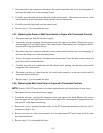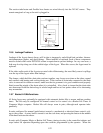
1-15
2) and the high-limit thermostat leads (pins 6 and 8) from the plug. Leave all other wires con-
nected. Leave the interface board lying on the shield.
13. Remove the louvered frame above the control panel opening.
14. Remove the screws securing the component shield to the fryer.
15. Disconnect the wires from components in component shield and mark to facilitate reconnection.
16. Disconnect the wires from the gas valve terminal block. Mark each wire to facilitate reconnec-
tion.
17. Remove the cover from the safety drain switch, disconnect the wires from the switch, and pull
them out of the switch box.
18. Pull up and forward on the component shield to clear the rear mounting stud on the front of the
frypot and remove it from the fryer by rotating its right side up and to the left.
19. Disconnect the pipe union on the right side of the gas valve.
20. On FM45 fryers, remove the section of square drain from the drain valve of the frypot to be re-
moved.
21. Remove the frypot hold down bracket.
22. Remove the screws from the flue cap sides and back and lift it clear of the fryer(s).
23. Remove the oil return line from the front of the frypot to be removed.
24. Lift the complete frypot assembly (frypot, burner, gas valve, and flue) from the fryer cabinet.
25. Transfer the burner heat shield and burner to the replacement frypot.
26. Remove the drain valve, thermostat or temperature probe, and high-limit thermostat and install
on replacement frypot.
CAUTION
Before installing the thermostat/temperature probe, high-limit thermostat, and drain valve
on the replacement frypot, clean their threads and apply Loctite™ PST56765 thread
sealant or equivalent to the threads.
27. Reverse steps 1-25 to reassemble the fryer.
1.9 Troubleshooting and Problem Isolation
Because it is not feasible to attempt to include in this manual every conceivable problem or trouble
condition that might be encountered, this section is intended to provide technicians with a general
knowledge of the broad problem categories associated with this equipment, and the probable causes
of each. With this knowledge, the technician should be able to isolate and correct any problem en-
countered.


















